Construction of Ternary Ce Metal–Organic Framework/Bi/BiOCl Heterojunction towards Optimized Photocatalytic Performance
Abstract
:1. Introduction
2. Materials and Methods
2.1. Chemicals
2.2. Methods
2.2.1. Synthesis of Ce-MOF
2.2.2. Synthesis of Bi/BiOCl
2.2.3. Synthesis of Ce-MOF/Bi/BiOCl
2.3. Characterizations
2.4. Measurement of Photocatalytic Activity
3. Results and Discussion
3.1. The Crystalline Phase Structure Analysis
3.2. The Morphology Analysis
3.3. The N2 Adsorption Analysis
3.4. The XPS and FT-IR Analysis
3.5. The UV-Vis Analysis
3.6. The Photocatalytic Performance
3.7. The Photocatalytic Mechanism and Stability Test
4. Conclusions
Author Contributions
Funding
Data Availability Statement
Conflicts of Interest
References
- Linghu, X.; Shu, Y.; Liu, L.; Zhao, Y.; Zhang, J.; Chen, Z.; Shan, D.; Wang, B. Hydro/solvothermally synthesized bismuth tungstate nanocatalysts for enhanced photocatalytic degradation of dyes, antibiotics, and bacteria in wastewater: A review. J. Water Process Eng. 2023, 54, 103994. [Google Scholar] [CrossRef]
- Li, S.; Cai, M.; Liu, Y.; Wang, C.; Yan, R.; Chen, X. Constructing Cd0.5Zn0.5S/Bi2WO6 S-scheme heterojunction for boosted photocatalytic antibiotic oxidation and Cr(VI) reduction. Adv. Powder Mater. 2023, 2, 100073. [Google Scholar]
- Dutta, V.; Sharma, S.; Raizada, P.; Khan, A.A.P.; Asiri, A.M.; Nadda, A.; Singh, P.; Van Le, Q.; Huang, C.-W.; Nguyen, D.L.T. Recent advances and emerging trends in (BiO)2CO3 based photocatalysts for environmental remediation: A review. Surf. Interfaces 2021, 25, 101273. [Google Scholar] [CrossRef]
- El Messaoudi, N.; Ciğeroğlu, Z.; Şenol, Z.M.; Elhajam, M.; Noureen, L. A comparative review of the adsorption and photocatalytic degradation of tetracycline in aquatic environment by g-C3N4-based materials. J. Water Process Eng. 2023, 55, 104150. [Google Scholar] [CrossRef]
- Dong, Y.; Wang, B.; Xie, D.; Lv, J.; Cui, J.; Bao, Z.; Xu, G.; Shen, W. Synergistic photoelectrocatalytic degradation of tetracycline using a novel Z-scheme Zn0.5Ni0.5Fe2O4/SiNWs heterostructure: Towards sustainable antibiotic remediation. EcoEnergy 2024, 10, ece2.54. [Google Scholar]
- Zheng, X.; Zhang, D.; Gao, Y.; Wu, Y.; Liu, Q.; Zhu, X. Synthesis and characterization of cubic Ag/TiO2 nanocomposites for the photocatalytic degradation of methyl orange in aqueous solutions. Inorg. Chem. Commun. 2019, 110, 107589. [Google Scholar] [CrossRef]
- Guo, K.; Yu, C.; Gao, B.; Liu, B.; Wang, Z.; Wang, Y.; Yue, Q.; Gao, Y. Intrinsic mechanism for the removal of antibiotic pollution by a dual coagulation process from the perspective of the interaction between NOM and antibiotic. Water Res. 2023, 244, 120483. [Google Scholar] [CrossRef] [PubMed]
- Deng, Y.-Y.; Zou, M.-Y.; Liu, W.; Lian, Y.-L.; Guo, Q.-M.; Zhang, X.-M.; Dan, A. Antibiotic removal and microbial response mechanism in constructed wetlands treating aquaculture wastewater containing veterinary drugs. J. Clean. Prod. 2023, 394, 136271. [Google Scholar] [CrossRef]
- Zhang, X.; Bhattacharya, T.; Wang, C.; Kumar, A.; Nidheesh, P.V. Straw-derived biochar for the removal of antibiotics from water: Adsorption and degradation mechanisms, recent advancements and challenges. Environ. Res. 2023, 237, 116998. [Google Scholar] [CrossRef] [PubMed]
- Homem, V.; Santos, L. Degradation and removal methods of antibiotics from aqueous matrices—A review. J. Environ. Manag. 2011, 92, 2304–2347. [Google Scholar] [CrossRef]
- Yang, Z.; Chen, Y.-W.; Jin, Y.-F.; Jin, Z.; Xie, H.-S.; Cong, X.-S.; Teng, D.-G. Ni, Co-embedded MOF-derived N-doped bimetallic porous carbon for adsorption–photocatalytic degradation of organic dyes and antibiotics. ACS Omega 2024, 9, 11356–11365. [Google Scholar] [CrossRef] [PubMed]
- Choi, Y.; Koo, M.S.; Bokare, A.D.; Kim, D.-H.; Bahnemann, D.W.; Choi, W. Sequential process combination of photocatalytic oxidation and dark reduction for the removal of organic pollutants and Cr (VI) using Ag/TiO2. Environ. Sci. Technol. 2017, 51, 3973–3981. [Google Scholar] [CrossRef] [PubMed]
- Meng, W.; Zeng, Y.; Liang, Z.; Guo, W.; Zhi, C.; Wu, Y.; Zhong, R.; Qu, C.; Zou, R. Tuning expanded pores in metal–organic frameworks for selective capture and catalytic conversion of carbon dioxide. ChemSusChem 2018, 11, 3751–3757. [Google Scholar] [CrossRef]
- Ahmadijokani, F.; Ghaffarkhah, A.; Molavi, H.; Dutta, S.; Lu, Y.; Wuttke, S.; Kamkar, M.; Rojas, O.J.; Arjmand, M. COF and MOF hybrids: Advanced materials for wastewater treatment. Adv. Funct. Mater. 2023, 34, 2305527. [Google Scholar] [CrossRef]
- Xia, T.; Lin, Y.; Li, W.; Ju, M. Photocatalytic degradation of organic pollutants by MOFs based materials: A review. Chin. Chem. Lett. 2021, 32, 2975–2984. [Google Scholar] [CrossRef]
- Qiao, Q.; Xu, Y.; Zhong, D.; Ke, X.; Yang, Y.; Zeng, H. Visible light responsive photocatalytic fuel cell with Ce-UiO-66/g-C3N4/Bi2WO6/Ti photoanode for simultaneous degradation of rhodamine B and electricity generation. Mater. Res. Bull. 2024, 179, 112960. [Google Scholar] [CrossRef]
- Kurmoo, M. Magnetic metal–organic frameworks. Chem. Soc. Rev. 2009, 38, 1353–1379. [Google Scholar] [CrossRef]
- Samiee, R.; Montazeri, S.; Ramezanzadeh, B.; Mahdavian, M. Ce-MOF nanorods/aluminum hydroxide (AlTH) synergism effect on the fire-retardancy/smoke-release and thermo-mechanical properties of a novel thermoplastic acrylic intumescent composite coating. Chem. Eng. J. 2022, 428, 132533. [Google Scholar] [CrossRef]
- Ding, Z.; Wang, S.; Chang, X.; Wang, D.-H.; Zhang, T. Nano-MOF@defected film C3N4 Z-scheme composite for visible-light photocatalytic nitrogen fixation. RSC Adv. 2020, 10, 26246–26255. [Google Scholar] [CrossRef]
- Chen, S.; Duan, X.; Liu, C.; Liu, S.; Li, P.; Su, D.; Sun, X.; Guo, Y.; Chen, W.; Wang, Z. La-Ce-MOF nanocomposite coated quartz crystal microbalance gas sensor for the detection of amine gases and formaldehyde. J. Hazard. Mater. 2024, 467, 133672. [Google Scholar] [CrossRef]
- Wu, Z.; Chen, Z.; Chen, J.; Ning, X.; Chen, P.; Jiang, H.; Qiu, H. Enhanced adsorption and synergistic photocatalytic degradation of tetracycline by MOF-801/GO composites via solvothermal synthesis. Environ. Sci. Nano 2022, 9, 4609–4618. [Google Scholar] [CrossRef]
- Jiang, W.; Li, Z.; Liu, C.; Wang, D.; Yan, G.; Liu, B.; Che, G. Enhanced visible-light-induced photocatalytic degradation of tetracycline using BiOI/MIL-125 (Ti) composite photocatalyst. J. Alloys Compd. 2021, 854, 157166. [Google Scholar] [CrossRef]
- Low, J.; Yu, J.; Jaroniec, M.; Wageh, S. AAJAm Al-Ghamdi. Heterojunction Photocatal. 2017, 29, 1601694. [Google Scholar]
- Goudarzi, M.D.; Khosroshahi, N.; Hamlehdar, A.; Safarifard, V. Construction of S-scheme heterojunction via incorporating g-C3N4 into Ce-based MOFs for promotion of charge-transfer in photocatalytic Cr (VI) detoxification. J. Environ. Chem. Eng. 2023, 11, 110169. [Google Scholar] [CrossRef]
- Huidobro, L.; Bautista, Q.; Alinezhadfar, M.; Gómez, E.; Serrà, A. Enhanced visible-light-driven peroxymonosulfate activation for antibiotic mineralization using electrosynthesized nanostructured bismuth oxyiodides thin films. J. Environ. Chem. Eng. 2024, 12, 112545. [Google Scholar] [CrossRef]
- Zhou, J.; Tang, H.; Yao, C.; Song, W.; Liu, C.; Song, W.; Zhang, Z. 2D/2D Ni-MOF/BiOCl S-scheme heterojunction with boosted charge transfer and photocatalytic degradation of tetracycline. Sustain. Mater. Technol. 2024, 39, e00825. [Google Scholar] [CrossRef]
- Wu, Z.; Shen, J.; Li, W.; Li, J.; Xia, D.; Xu, D.; Zhang, S.; Zhu, Y. Electron self-sufficient core-shell BiOCl@ Fe-BiOCl nanosheets boosting Fe (III)/Fe (II) recycling and synergetic photocatalysis-Fenton for enhanced degradation of phenol. Appl. Catal. B Environ. 2023, 330, 122642. [Google Scholar] [CrossRef]
- Ni, Q.; Ke, X.; Qian, W.; Yan, Z.; Luan, J.; Liu, W. Insight into tetracycline photocatalytic degradation mechanism in a wide pH range on BiOI/BiOBr: Coupling DFT/QSAR simulations with experiments. Appl. Catal. B Environ. 2024, 340, 123226. [Google Scholar] [CrossRef]
- Zhang, X.; Chen, J.; Jiang, S.; Zhang, X.; Bi, F.; Yang, Y.; Wang, Y.; Wang, Z. Enhanced photocatalytic degradation of gaseous toluene and liquidus tetracycline by anatase/rutile titanium dioxide with heterophase junction derived from materials of Institut Lavoisier-125 (Ti): Degradation pathway and mechanism studies. J. Colloid Interface Sci. 2021, 588, 122–137. [Google Scholar] [CrossRef]
- Wu, S.; Yu, X.; Zhang, J.; Zhang, Y.; Zhu, Y.; Zhu, M. Construction of BiOCl/CuBi2O4 S-scheme heterojunction with oxygen vacancy for enhanced photocatalytic diclofenac degradation and nitric oxide removal. Chem. Eng. J. 2021, 411, 128555. [Google Scholar] [CrossRef]
- Ju, Y.; Wang, Z.; Lin, H.; Hou, R.; Li, H.; Wang, Z.; Zhi, R.; Lu, X.; Tang, Y.; Chen, F. Modulating the microenvironment of catalytic interface with functional groups for efficient photocatalytic degradation of persistent organic pollutants. Chem. Eng. J. 2024, 479, 147800. [Google Scholar] [CrossRef]
- He, Y.; Li, J.; Li, K.; Sun, M.; Yuan, C.; Chen, R.; Sheng, J.; Leng, G.; Dong, F. Bi quantum dots implanted 2D C-doped BiOCl nanosheets: Enhanced visible light photocatalysis efficiency and reaction pathway. Chin. J. Catal. 2020, 41, 1430–1438. [Google Scholar] [CrossRef]
- Yang, X.; Sun, S.; Cui, J.; Yang, M.; Luo, Y.; Liang, S. Synthesis, functional modifications, and diversified applications of hybrid BiOCl-based heterogeneous photocatalysts: A review. Cryst. Growth Des. 2021, 21, 6576–6618. [Google Scholar] [CrossRef]
- Yang, X.; Sun, S.; Cui, J.; Yang, M.; Yang, Q.; Xiao, P.; Liang, S. One-pot construction of robust BiOCl/ZnO p–n heterojunctions with semi-coherent interfaces toward improving charge separation for photodegradation enhancement. Nanoscale Adv. 2021, 3, 4851–4857. [Google Scholar] [CrossRef]
- Chen, P.; Liu, H.; Sun, Y.; Li, J.; Cui, W.; Zhang, W.; Yuan, X.; Wang, Z.; Zhang, Y.; Dong, F. Bi metal prevents the deactivation of oxygen vacancies in Bi2O2CO3 for stable and efficient photocatalytic NO abatement. Appl. Catal. B Environ. 2020, 264, 118545. [Google Scholar] [CrossRef]
- Song, D.; Li, M.; Yang, F.; Yu, M.; Li, Z.; Chen, J.; Zhang, X.; Zhou, W. Plasmon Bi in-situ anchored on BiOCl nanosheets assembled microspheres towards optimized photothermal-photocatalytic performance. Chin. Chem. Lett. 2024, 35, 108591. [Google Scholar] [CrossRef]
- Wang, H.; Zhang, W.; Li, X.; Li, J.; Cen, W.; Li, Q.; Dong, F. Highly enhanced visible light photocatalysis and in situ FT-IR studies on Bi metal@ defective BiOCl hierarchical microspheres. Appl. Catal. B Environ. 2018, 225, 218–227. [Google Scholar] [CrossRef]
- Ding, J.; Su, G.; Zhou, Y.; Yin, H.; Wang, S.; Wang, J.; Zhang, W. Construction of Bi/BiOI/BiOCl Z-scheme photocatalyst with enhanced tetracycline removal under visible light. Environ. Pollut. 2024, 341, 122942. [Google Scholar] [CrossRef] [PubMed]
- Zhang, H.; Wang, J.; Teng, Y.; Jia, S.; Huang, H.; Li, Y.; Wang, C. Ce-MOF composite electrospinning as antibacterial adsorbent for the removal of 2, 4-dichlorophenoxyacetic acid. Chem. Eng. J. 2023, 462, 142195. [Google Scholar] [CrossRef]
- Hu, L.; Chen, J.; Wei, Y.; Wang, M.; Xu, Y.; Wang, C.; Gao, P.; Liu, Y.; Liu, C.; Song, Y. Photocatalytic degradation effect and mechanism of Karenia mikimotoi by non-noble metal modified TiO2 loading onto copper metal organic framework (SNP-TiO2@ Cu-MOF) under visible light. J. Hazard. Mater. 2023, 442, 130059. [Google Scholar] [CrossRef]
- Ye, G.; Shi, G.; Wang, H.; Zeng, X.; Wu, L.; Zhou, J.; Zhang, Q.; Wei, J.; Li, Z.; Nie, L. In Situ Implanting ZrW2O7(OH)2(H2O)2 Nanorods into Hierarchical Functionalized Metal-Organic Framework via Solvent-Free Approach for Upgrading Catalytic Performance. Small 2024, 20, 2311249. [Google Scholar] [CrossRef] [PubMed]
- Lai, M.T.L.; Lee, K.M.; Yang, T.C.K.; Lai, C.W.; Chen, C.-Y.; Johan, M.R.; Juan, J.C. Highly effective interlayer expanded MoS2 coupled with Bi2WO6 as pn heterojunction photocatalyst for photodegradation of organic dye under LED white light. J. Alloys Compd. 2023, 953, 169834. [Google Scholar] [CrossRef]
- Ren, S.; Dong, J.; Duan, X.; Cao, T.; Yu, H.; Lu, Y.; Zhou, D. A novel (Zr/Ce) UiO-66 (NH2)@g-C3N4 Z-scheme heterojunction for boosted tetracycline photodegradation via effective electron transfer. Chem. Eng. J. 2023, 460, 141884. [Google Scholar] [CrossRef]
- Wu, S.; Li, X.; Tian, Y.; Lin, Y.; Hu, Y. Excellent photocatalytic degradation of tetracycline over black anatase-TiO2 under visible light. Chem. Eng. J. 2021, 406, 126747. [Google Scholar] [CrossRef]
- Zhang, B.; Xu, H.; Wang, M.; Su, L.; Wu, C.; Wang, Q. Construction of a novel Bi-MOF/BiVO4 heterojunction with enhanced visible light photocatalytic performance. J. Environ. Chem. Eng. 2023, 11, 110417. [Google Scholar] [CrossRef]
- Xie, T.; Sun, S.; Shi, Z.; Zhang, J.; Yang, M.; Cui, J.; Yang, B. Facile construction of type-II Sn-doping BiOCl/WO3 heterojunction with enhanced visible-lightresponse and charge separation toward the application in photocatalysis. Mater. Today Chem. 2024, 35, 101869. [Google Scholar] [CrossRef]
- Yuan, X.; Yang, J.; Yao, Y.; Shen, H.; Meng, Y.; Xie, B.; Ni, Z.; Xia, S. Preparation, characterization and photodegradation mechanism of 0D/2D Cu2O/BiOCl S-scheme heterojunction for efficient photodegradation of tetracycline. Sep. Purif. Technol. 2022, 291, 120965. [Google Scholar] [CrossRef]
- Liu, M.; Ye, P.; Wang, M.; Wang, L.; Wu, C.; Xu, J.; Chen, Y. 2D/2D Bi-MOF-derived BiOCl/MoS2 nanosheets S-scheme heterojunction for effective photocatalytic degradation. J. Environ. Chem. Eng. 2022, 10, 108436. [Google Scholar]
- Luo, X.; Zhu, P.; Xie, T.; Liang, T.; Qiu, Q. Oxygen vacancy and Ce ion co-synergize to enhance the photocatalytic degradation performance of FeTiO3: An experimental and DFT study. Appl. Surf. Sci. 2024, 669, 160415. [Google Scholar] [CrossRef]
- Zou, X.; Li, C.; Wang, L.; Wang, W.; Bian, J.; Bai, H.; Meng, X. Enhanced visible-light photocatalytic degradation of tetracycline antibiotic by 0D/2D TiO2 (B)/BiOCl Z-scheme heterojunction: Performance, reaction pathways, and mechanism investigation. Appl. Surf. Sci. 2023, 630, 157532. [Google Scholar] [CrossRef]
- Hou, C.; Liu, Y.; Li, Y.; Xie, Y.; Luo, P.; Zhang, M.; Wang, L. Construction of an S-scheme Ce/Ti-MOFs heterojunction with abundant Oxygen vacancies (Ovs) for efficient charges separation: Performance and mechanism insight. J. Water Process Eng. 2023, 56, 104585. [Google Scholar] [CrossRef]
- Ye, Z.; Li, J.; Zhou, M.; Wang, H.; Ma, Y.; Huo, P.; Yu, L.; Yan, Y. Well-dispersed nebula-like ZnO/CeO2@ HNTs heterostructure for efficient photocatalytic degradation of tetracycline. Chem. Eng. J. 2016, 304, 917–933. [Google Scholar] [CrossRef]
- Zhang, Q.; Jiang, L.; Wang, J.; Zhu, Y.; Pu, Y.; Dai, W. Photocatalytic degradation of tetracycline antibiotics using three-dimensional network structure perylene diimide supramolecular organic photocatalyst under visible-light irradiation. Appl. Catal. B Environ. 2020, 277, 119122. [Google Scholar] [CrossRef]
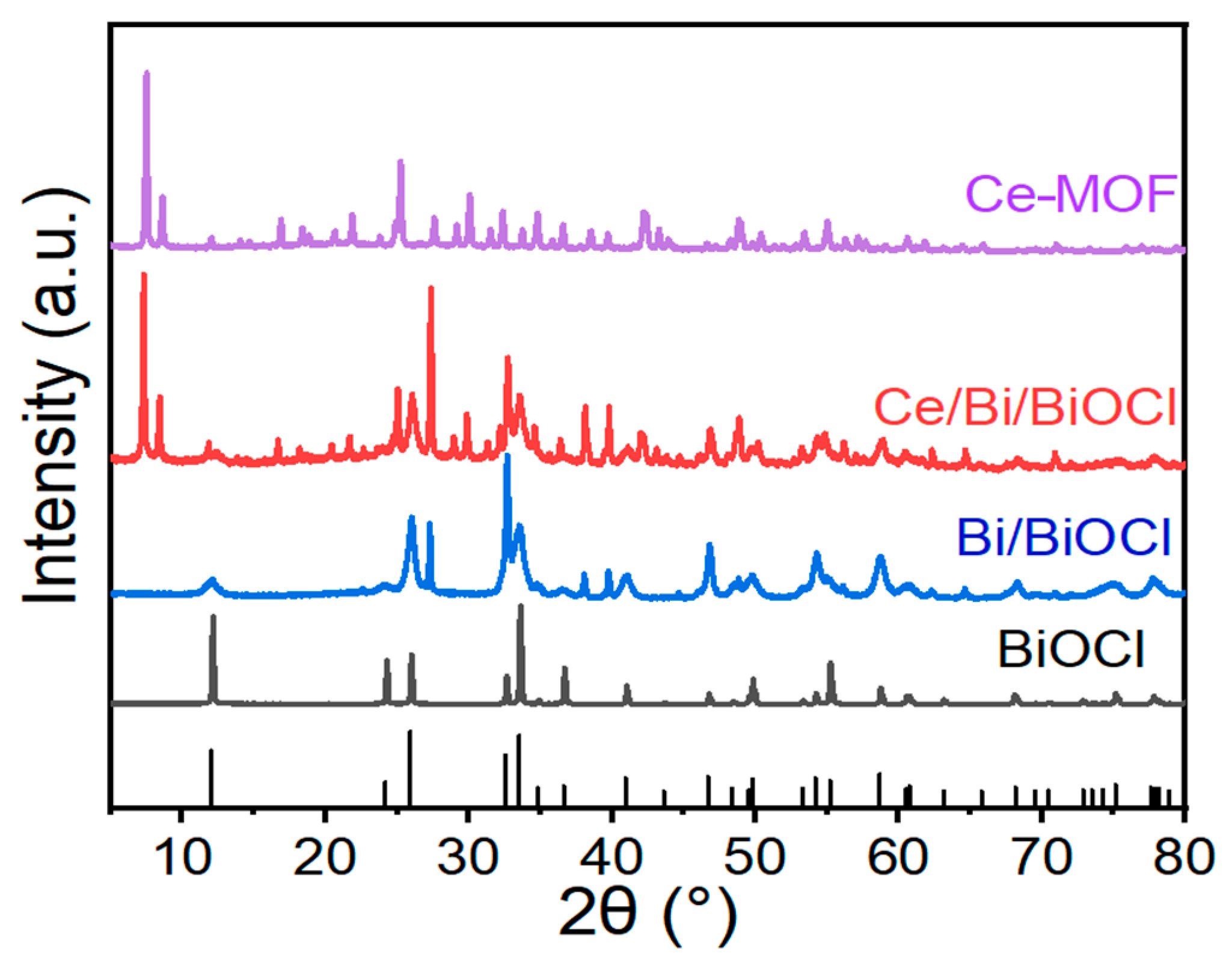


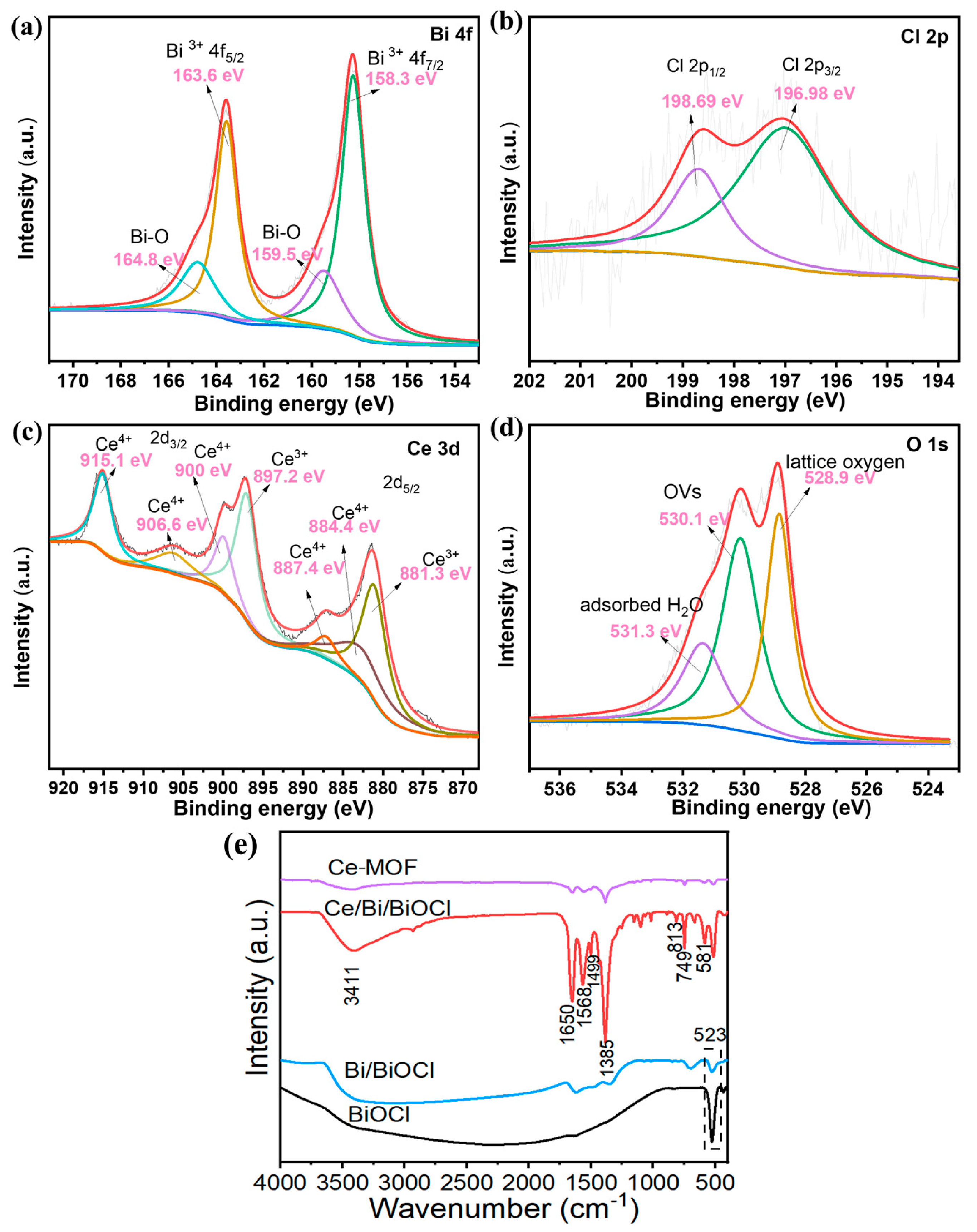
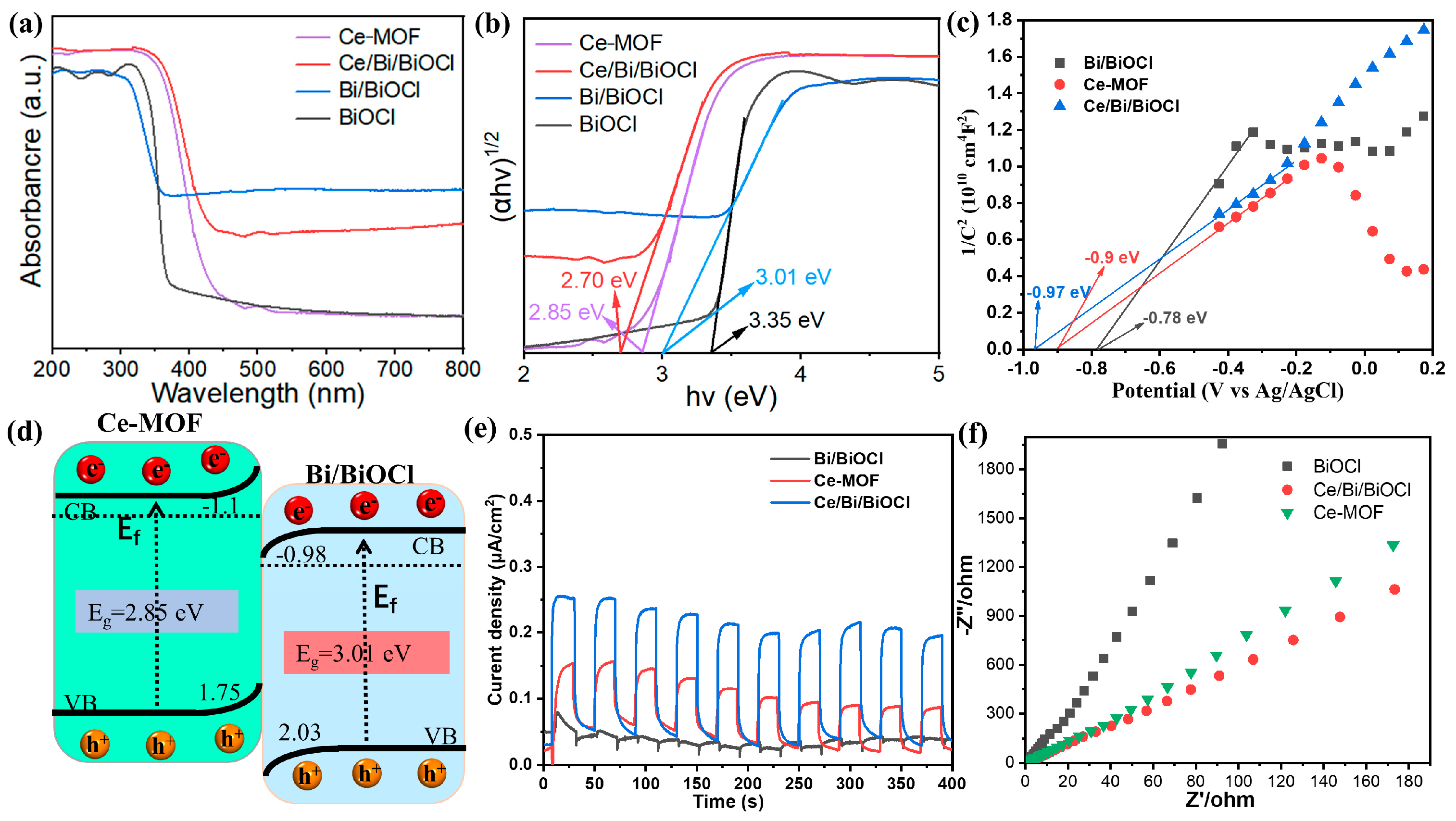

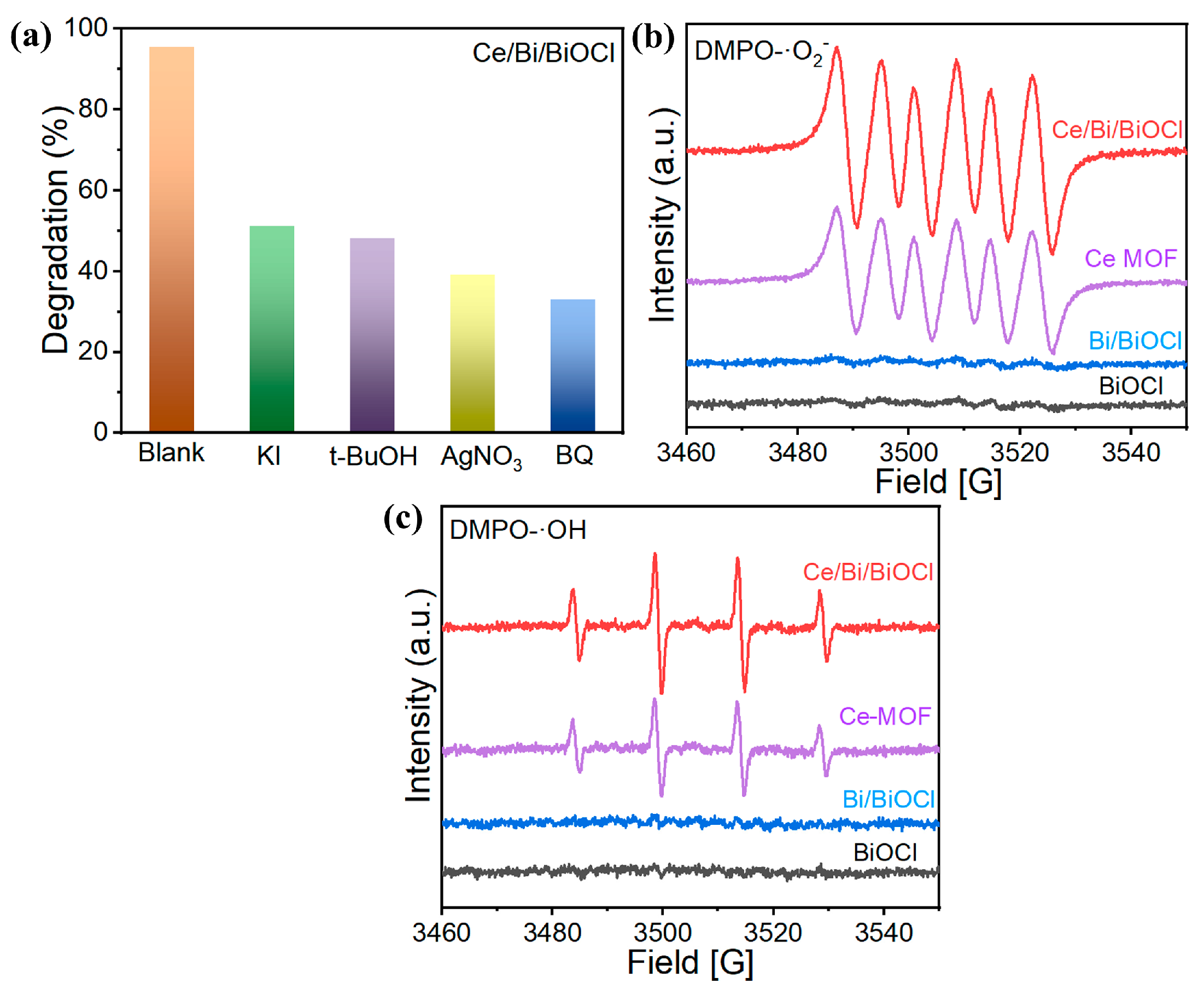
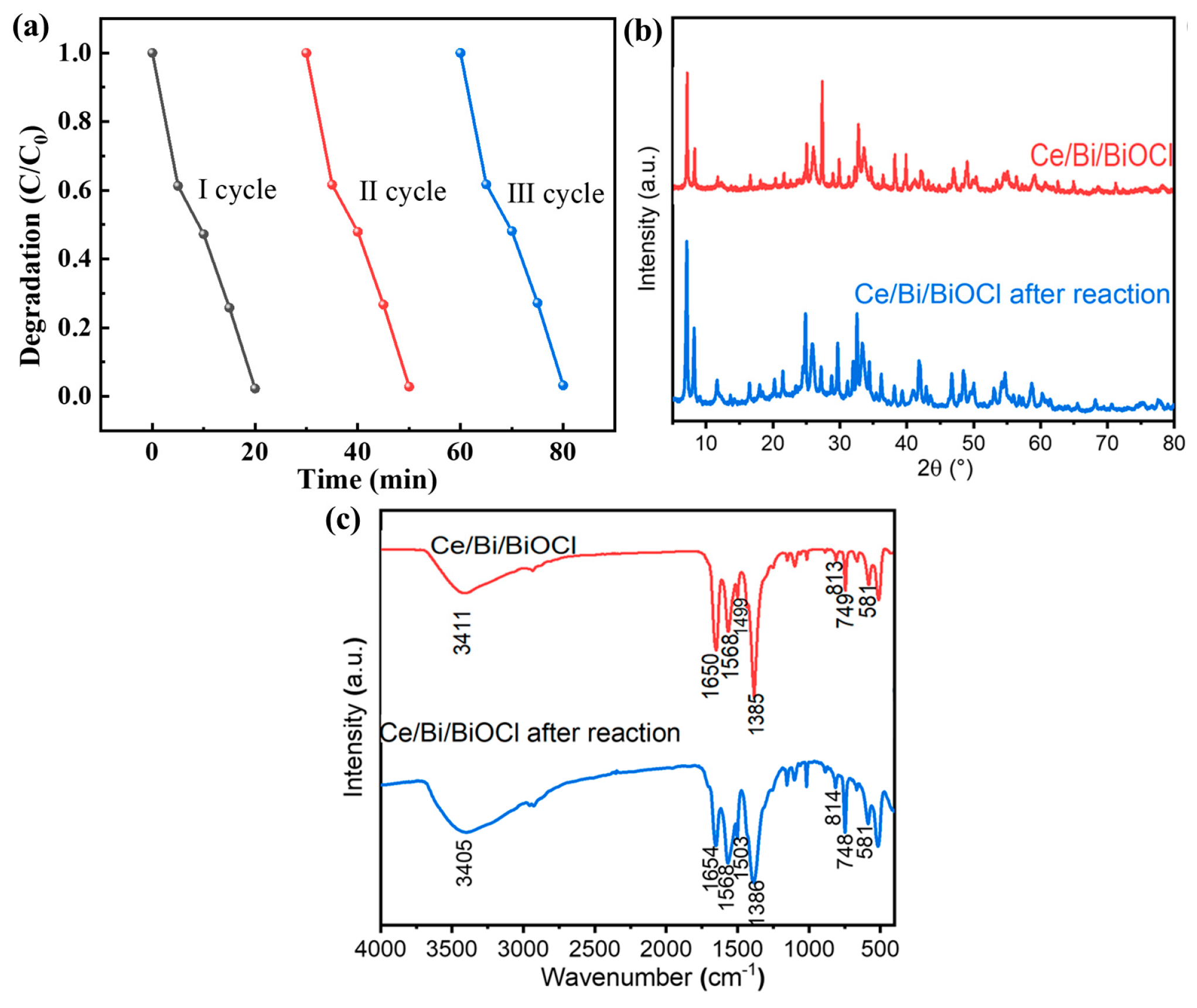
| Catalysts | SBET (m2/g) | Pore Size (nm) | Pore Volume (cm3/g) |
|---|---|---|---|
| SBET (m2/g) | 12.3 | 3.6 | 0.53 |
| Pore Volume (cm3/g) | 814 | 7.5 | 0.28 |
| Pore Size (nm) | 518 | 8.5 | 0.21 |
| Photocatalysts | Pollutant | Degradation Efficiency | Kinetic Constants | Reference |
|---|---|---|---|---|
| Ce/Bi/BiOCl | TC | 97.7% (20 min) | 0.137 | This work |
| 0.2-(Zr/Ce)UiO-66 (NH2)@CN | TC | 98% (120 min) | 0.026 | [43] |
| ZIF-67@Ce-MOF-600 | TC | 99.2% (30 min) (PMS) | 0.073 | [20] |
| B-TiO2 | TC | 66.2% (270 min) | 4.50 × 10−3 | [44] |
| BiBDC/BiVO4 | TC | 97.9% (30 min) | 0.1295 | [45] |
| BiOI/BiOBr-6 | TC | 90.61% (90 min) | 1.0799 | [28] |
| (BOC/WO)–Sn-Tu1 | TC | 71.68% (50 min) | 0.0131 | [46] |
| 0D/2D CuO/BiOCl | TC | 90.3% (80 min) | / | [47] |
| MOF-BiOCl/MoS | TC | 90% (20 min) | 0.104 | [48] |
| Ce/FeTiO3 | TC | 97.50% (120 min) | 0.02078 | [49] |
| OD/2D TiO2 (B)/BiOCl | TC | 86% (1 h) | 0.03671 | [50] |
| Ce/Ti-MOF | TC | 90% (2 h) | 0.01243 | [51] |
Disclaimer/Publisher’s Note: The statements, opinions and data contained in all publications are solely those of the individual author(s) and contributor(s) and not of MDPI and/or the editor(s). MDPI and/or the editor(s) disclaim responsibility for any injury to people or property resulting from any ideas, methods, instructions or products referred to in the content. |
© 2024 by the authors. Licensee MDPI, Basel, Switzerland. This article is an open access article distributed under the terms and conditions of the Creative Commons Attribution (CC BY) license (https://creativecommons.org/licenses/by/4.0/).
Share and Cite
Gao, T.; Chu, H.; Wang, S.; Li, Z.; Zhou, W. Construction of Ternary Ce Metal–Organic Framework/Bi/BiOCl Heterojunction towards Optimized Photocatalytic Performance. Nanomaterials 2024, 14, 1352. https://doi.org/10.3390/nano14161352
Gao T, Chu H, Wang S, Li Z, Zhou W. Construction of Ternary Ce Metal–Organic Framework/Bi/BiOCl Heterojunction towards Optimized Photocatalytic Performance. Nanomaterials. 2024; 14(16):1352. https://doi.org/10.3390/nano14161352
Chicago/Turabian StyleGao, Teng, Hongqi Chu, Shijie Wang, Zhenzi Li, and Wei Zhou. 2024. "Construction of Ternary Ce Metal–Organic Framework/Bi/BiOCl Heterojunction towards Optimized Photocatalytic Performance" Nanomaterials 14, no. 16: 1352. https://doi.org/10.3390/nano14161352






